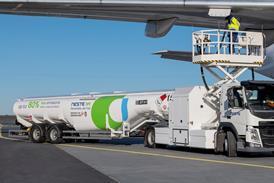The GE Honda Aero Engines team has shipped two HF120 turbofan engines with modified fan blisks for Honda's F2 flight test aircraft in North Carolina following a redesign of the titanium components after icing tests earlier this year. The aircraft is expected to join the test programme in November.
News of the engine redesign and an associated certification slip for the twin-engine $4.5 million HondaJet was revealed by Honda Aircraft chief executive and president Michimasa Fujino at the National Business Aviation Association (NBAA) trade show in Las Vegas in early October. Originally slated for certification and deliveries in the second half of 2012, the six-passenger light business jet will now be delayed until the second half of 2013 because of the extra time needed for engine and aircraft-level retesting.
 |
|---|
© Honda Aircraft |
During Part 33 engine certification testing in February, the HF120 failed an "ice slab" test in which 0.25in-thick slabs of ice are injected into the engine at full power during ground tests at GE's Peebles, Ohio facility. The test simulates airframe ice breaking off and entering the engine. The 1,950lb take-off thrust (8.7kN) HF120, which features a one-piece titanium fan (also known as a blisk), experienced a "minor" power loss after the ingestion due to blade damage. The level of power loss apparently exceeded the test criteria of minimal or no-loss of power.
Engineers then redesigned the fan blade, increasing the thickness of the leading edge of the 16 fan blades on the blisk and changing the manufacturing process for the component. The redesigned fan has passed the ice slab test, but a series of other tests, such as blade-out demonstrations and a 150h endurance block test, must be rerun for the new design. GE says it has completed a successful rig-level blade out test, which provided confidence in the design ahead of the forthcoming certification blade-out test. GE Honda Aero engines will use seven engines with the enhanced fan design for the overall Part 33 engine certification programme, which it expects to complete in the second quarter of 2012, followed by US Federal Aviation Administration certification of the engine in the second half of 2012.
Source: Flight International























